One rainy Sunday afternoon in Erbil we found an English pub called Two Princes. We didn’t expect to find an English pub in Iraqi Kurdistan but there it was, and the rain was coming down with steadily increasing force, so in we went. We were hoping for Sunday Roast, but they didn’t have it so we settled for some day-drinking instead. When we tried to leave the bartender said ‘But it’s raining dogs and cats’, so we stayed for another round.
We had some work to do. We loathe making itineraries, let alone sticking to them. Usually we just figure things out as we go. But it’s a different story in Turkmenistan, our next destination. Turkmenistan’s Ministry of Information and Culture – the people who hand out the visas, or not – have no patience for the whims of travelers who don’t like planning in advance.
Everyone knows it’s not easy to get into Turkmenistan. Ok, a lot of people probably haven’t heard of Turkmenistan. But once you do, you mainly hear how hard it is to visit. To get a visa you need visa support and that means booking everything ahead through a tour operator – accommodation, transportation, and an itinerary listing every place you’ll go and every thing you’ll do. Independent travel is not allowed in Turkmenistan. The entire time you’re there, you’re under the mandatory supervision of a guide or driver, or both. And even applications meeting the full criteria can be arbitrarily denied.
Starting my pre-travel research, I read: ‘The country is known for its autocratic government and large gas reserves’. Sounds fascinating, right? Well, having got the visa, I can say that yes, it definitely is.
So why all the visa-fuss? Basically, Turkmenistan doesn’t care about tourism. Consequently, it’s one of the least visited countries in the world. It’s always been difficult to get there. Prior to 1989 Turkmenistan was part of the Soviet Union, so there was that. Post independence in 1991, they’ve had three eccentric dictators in a row and the country has more or less been closed to the outside world.
To give you a hint of what I mean by eccentric: the first President, Saparmurat Niyazov, styled himself Turkmenbashi or ‘The father of all Turkmen’ and then set about establishing the weirdest personality cult ever. He wrote a book called Ruhnama – his thoughts on Turkmen identity, history, and destiny – and made it mandatory curriculum in schools. He named days and months after himself and his family members. He banned the opera, ballet, and circuses for being ‘insufficiently Turkmen’. He commissioned a giant, rotating, gold statue of himself.
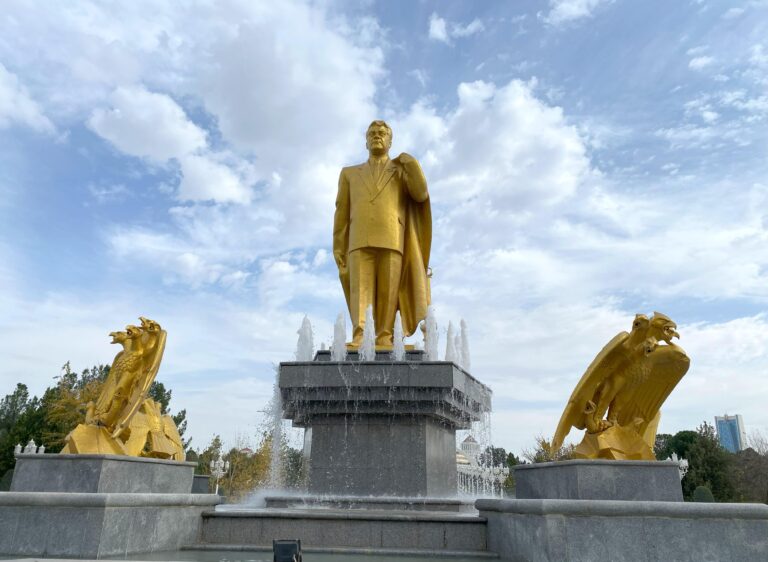
After Niyazov’s death in 2006 the next president, Gurbanguly Berdimuhamedow returned the calendar to normal and repealed some of his predecessor’s rules. But he brought in some other winning policies such as a ban on cars of any color other than white, in the capital city Ashgabat. In 2022 Gurbanguly’s son Serdar won a non-democratic election, and now shares power with his father.
Anyway, all that itinerary-making and visa support was driving us to distraction and that’s why we spent the rainy day in the English pub in Iraqi Kurdistan.
Plus, we had another concern. One evening some time ago in Turkey I’d noticed Oyv’s face was bright pink, even brighter pink than is normal for him. Both of us had a headache but blamed it on an afternoon spent in yet another stuffy mausoleum. But I started sniffling like mad and sure enough, it was Covid. Not a huge concern in most places anymore, but Turkmenistan isn’t most places. Apparently, Covid doesn’t exist there and never has. They didn’t reopen their borders until April 2023 and PCRs on arrival are still mandatory. Theoretically, anyone testing positive will go into a 14 day quarantine and neither of us relished the prospect. We were both recovered by now but since PCR tests can show positive for weeks afterwards, we were slightly worried one of us might become Turkmenistan’s patient zero.
Nevertheless, having made this nightmarish itinerary we were determined to stick to it, or at least try to. So it was with some trepidation that we boarded our flight to Ashgabat.
A shining white city in the desert
As it turned out, Turkmenistan is keen to keep its Covid-free status. The PCR on arrival we’d been dreading consisted of a girl twirling a swab in the general vicinity of our nostrils, and then throwing it out. We stood in queues for two hours doing Soviet-style paperwork in triplicate, and then exited the airport. We told our driver we were happy to see him, since we’d half-expected to land up in quarantine. He laughed and wiggled his eyebrows: ‘No one ever had Covid here, but in 2020 we all got pneumonia’. He dropped us off at the hotel and just a few hours later it was time to meet Arslan, our guide, and get our first look at Ashgabat.
You don’t so much look at Ashgabat, as squint and shade your eyes from the white glare of marble, especially in harsh winter sunlight.
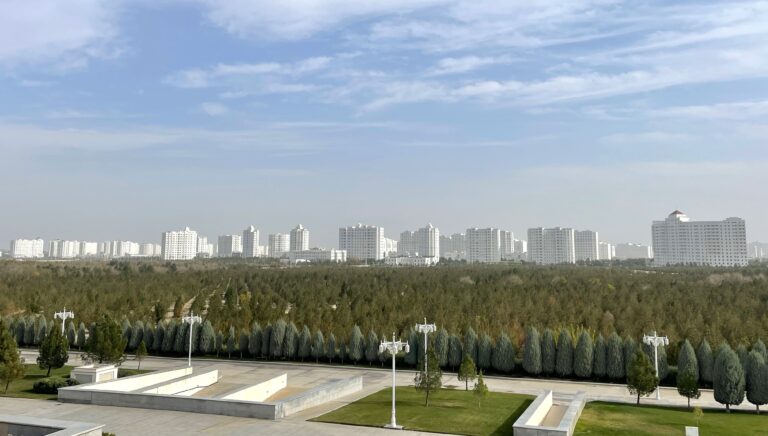
The original city mostly collapsed in an earthquake in 1948, and was rebuilt after that in communist-chic. Older parts of the city retain that dreary blockish look, but after independence the first President spared no expense in redoing the city center in marble and monuments. The broad boulevards are eerily empty of traffic, and spotless. Armies of groundskeepers were often the only people around, sweeping and gardening with a vengeance. The actual army is also there to make sure that nobody gets too close to the Presidential Palace or any pristine stretch of grass.
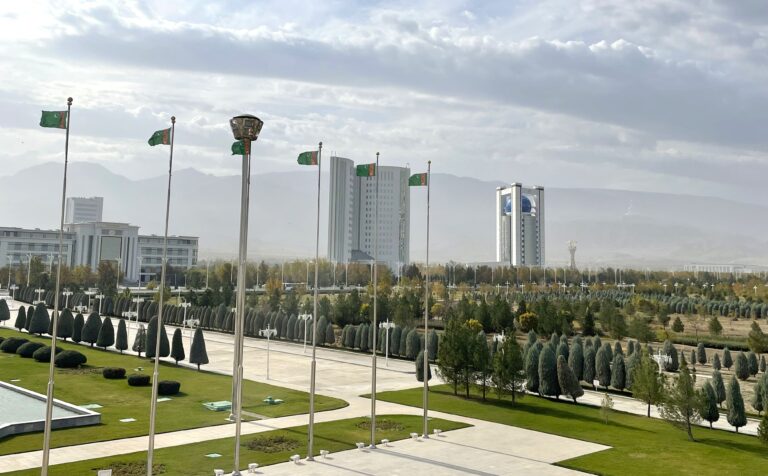
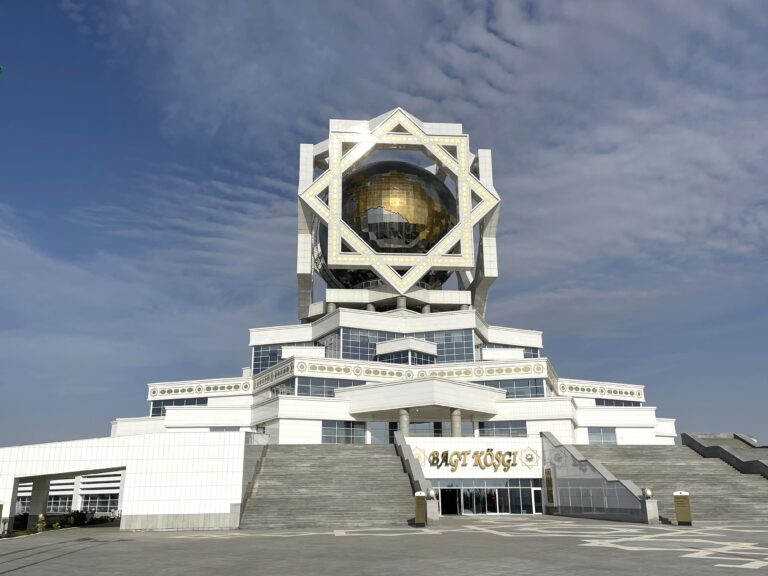
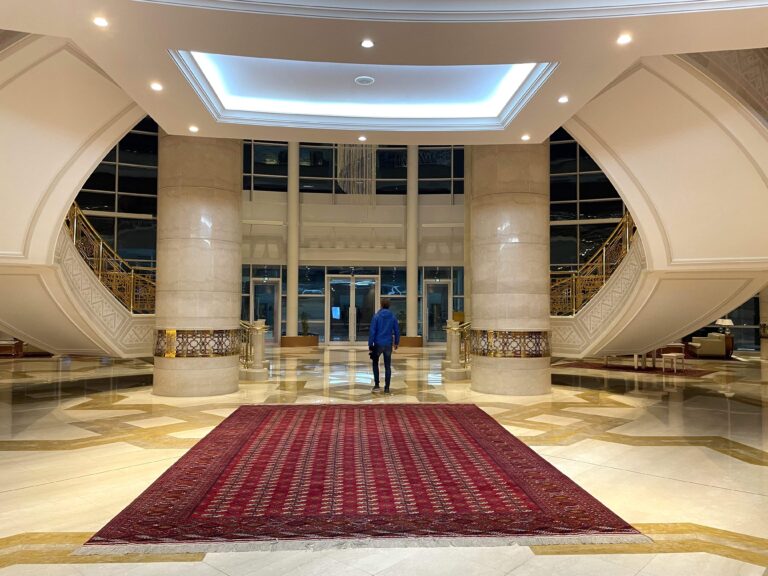
We quickly learned that world records for obscure and pointless things are very dear to the Turkmen heart. In addition to the highest density of marble-clad buildings in the world, Ashgabat has the most fountain pools in a public place, and the world’s largest indoor ferris wheel.
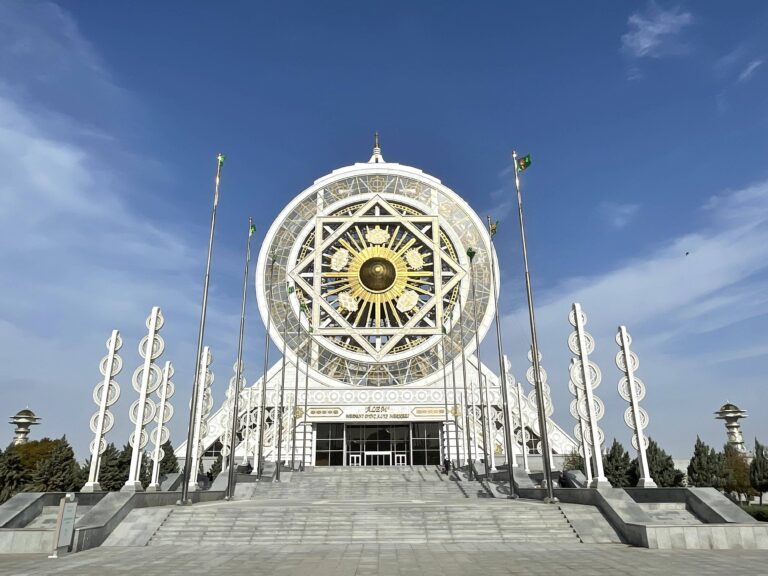
The ferris wheel is in a darkened building and for about a dollar a man turned it on and let us go for a spin. Absolutely no one else was there and it was actually a bit spooky, like a theme park after Armageddon.
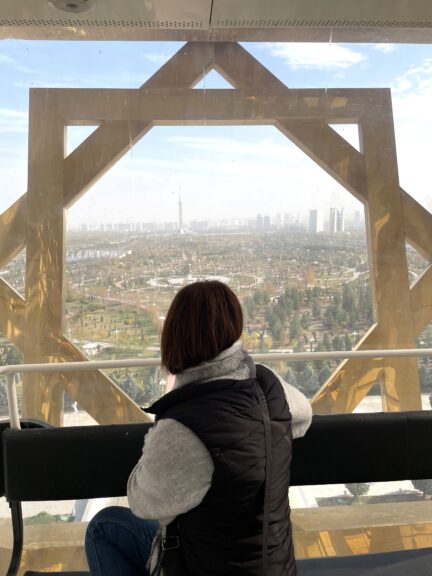
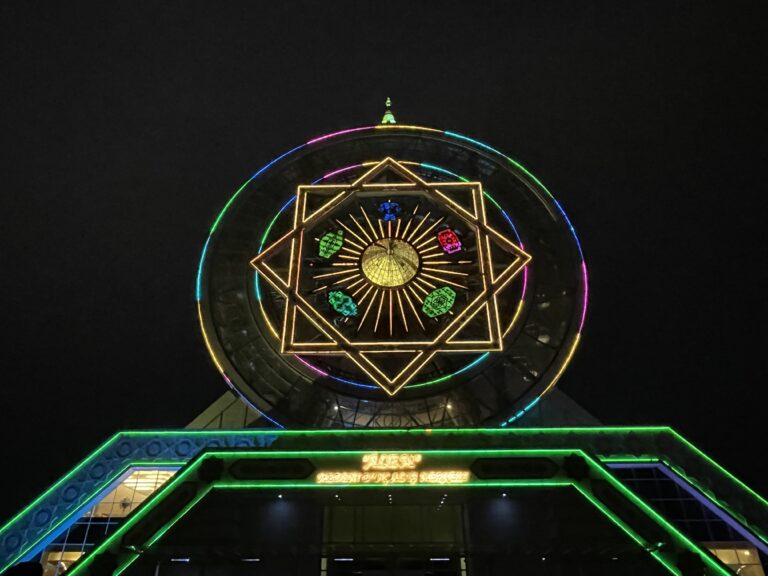
Turkmenistan is the only country in the world that’s officially neutral – and they’ve got a monument to prove it.
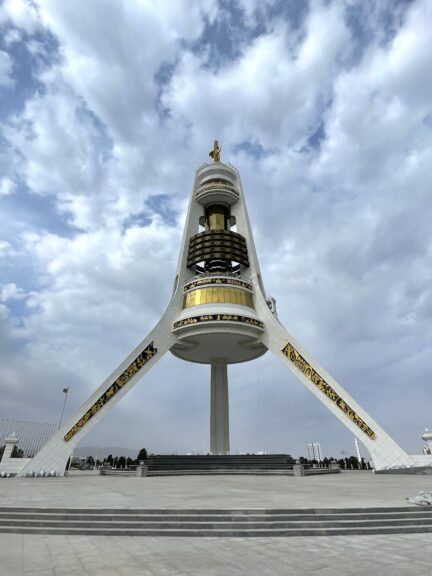
Although the Ruhnama has been removed from standard curriculum, there’s still a big statue of it. Besides commemorating his book with a statue, the first President had a copy launched into space to orbit the Earth for 150 years.
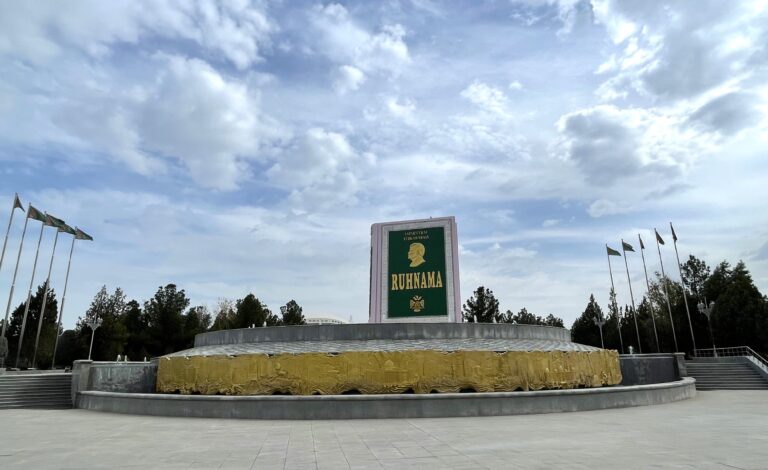
We were allowed some free time to walk around unsupervised in Ashgabat. ‘There are plenty of cameras, anyway’ said Arslan. We got too close to the Presidential Palace. All that happened was the soldiers outside patrolling around some of the many world-record-setting fountains, asked us for cigarettes and money, then sent us away.
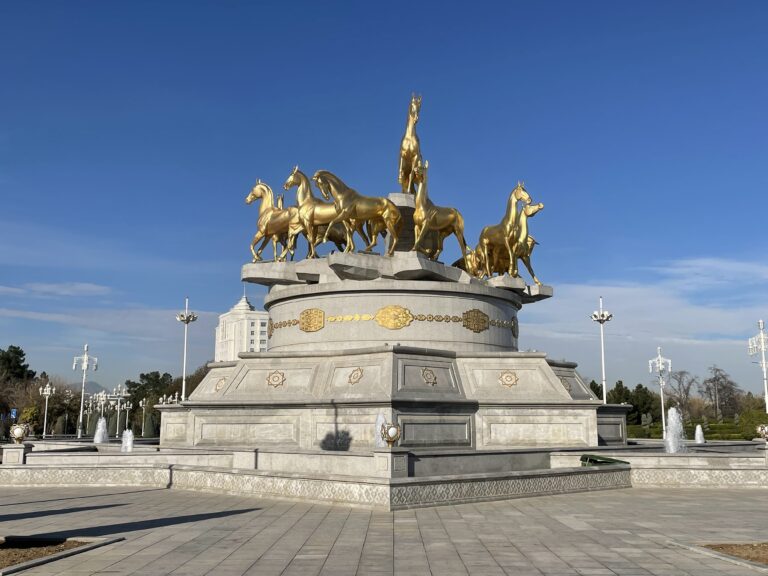
A length of Silk Road
The Silk Road runs through Turkmenistan and some of the most important cities on that famous thoroughfare were here. Thousands of travelers poured through these oasis-cities to trade in everything from silk and spices to religion and culture. In today’s Turkmenistan, we had these ruined ancient outposts to ourselves. Well, to ourselves and Arslan, anyway.
There’s Nisa, at first a Parthian royal residence (or possibly a mausoleum, or maybe a ceremonial center) from 250 BC. The Parthians were a major power at the time, and major enemies of the Romans. At its peak Nisa was a center of art and study. An earthquake destroyed the original site in the first decade BC. The city that followed, an oasis on the Silk Road, was in turn destroyed by the Mongols in the 13th century.
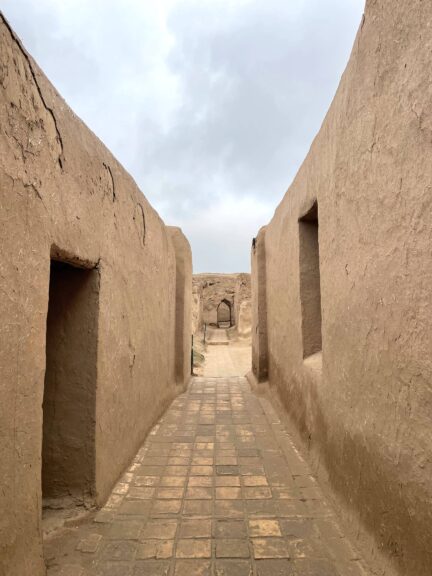
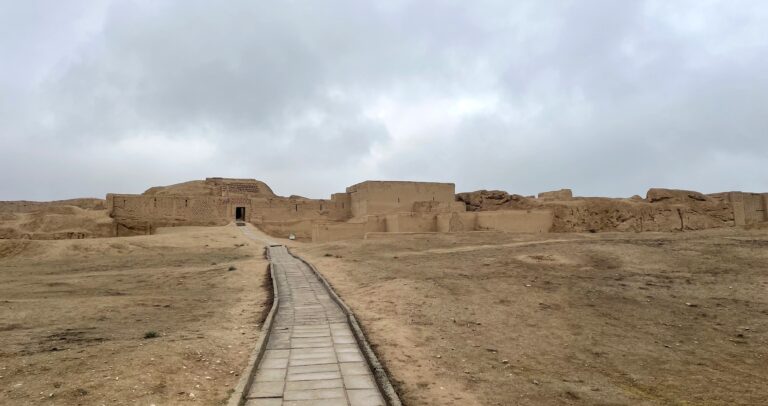
Merv is one of the oldest cities in Central Asia. In the 12th to 13th centuries it might have even been the biggest city in the world. Fitting for Turkmenistan, I thought. It’s just a shame they didn’t have the Guinness Book of World Records in the 1200s.
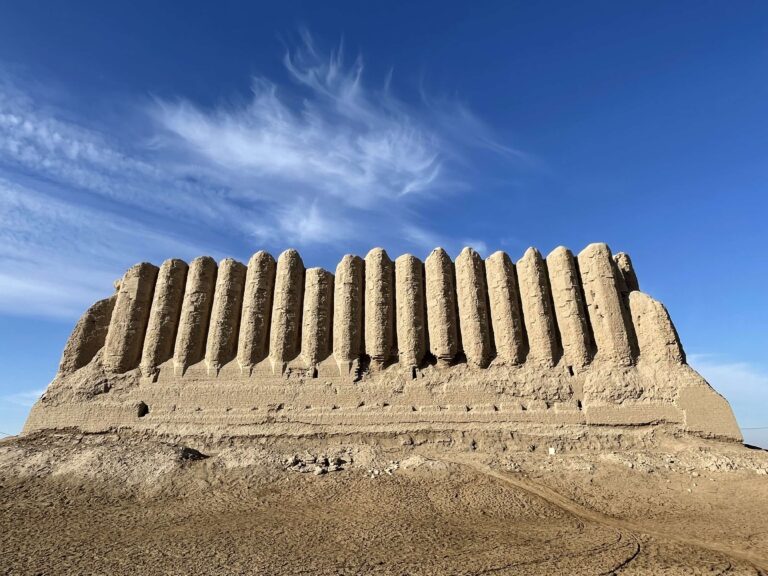
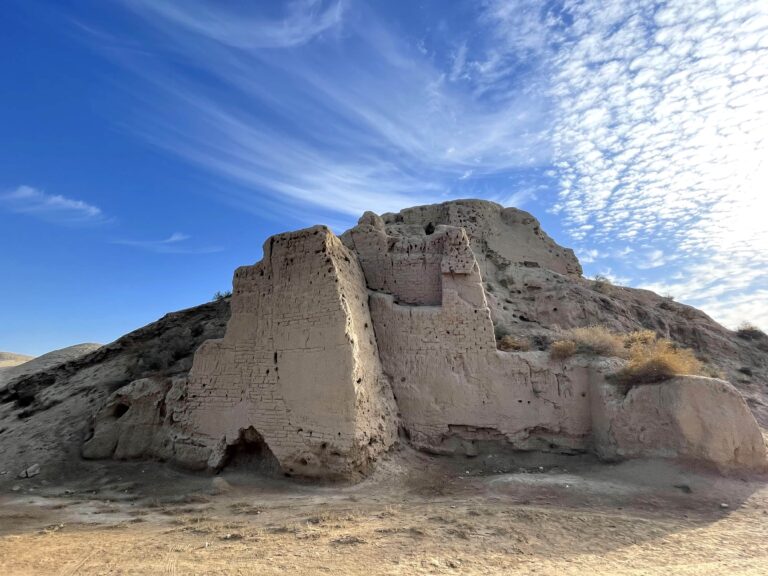
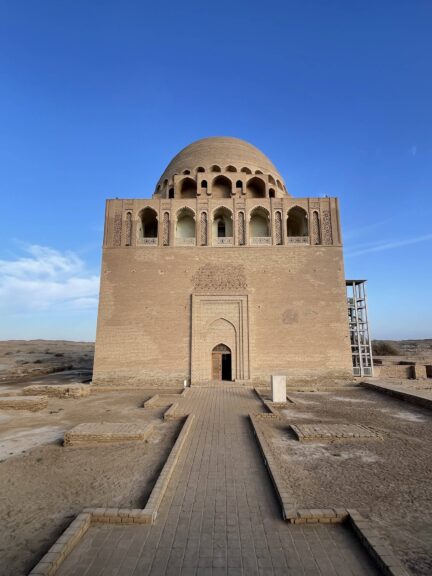
What they did have in the 1200s was Mongol hordes. When Tolui Khan – you’ve heard of his more famous father, Genghis Khan – invaded in 1221, the result for Merv was nearly total annihilation. Although partially rebuilt afterwards, the city never really recovered.
A cave, a canyon, and the Caspian Sea
We saw a lot of Turkmenistan, which is to say that we saw a lot of desert. Over 70 percent of this country is swallowed up in the Karakum desert. When we weren’t driving endlessly towards an ever-distant vanishing point in the dust, we were riding the train through it.

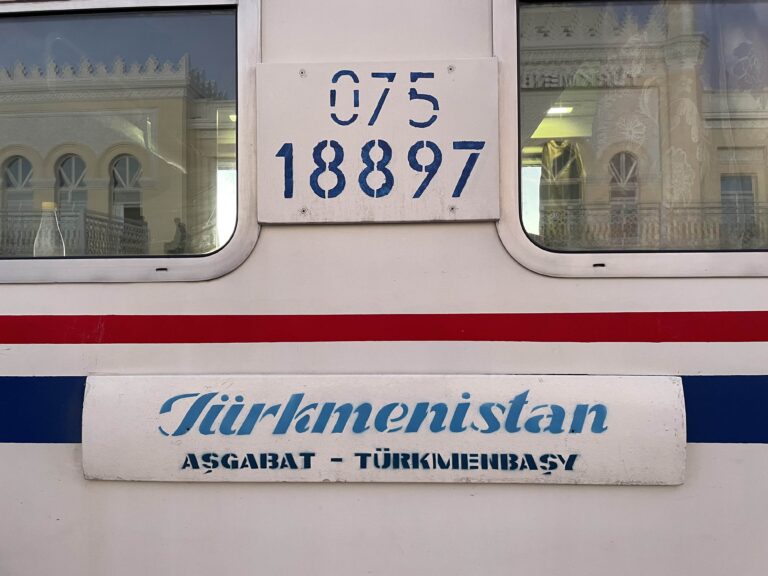
It stands to reason that you might not think of swimming on a trip to Turkmenistan. But then you thought wrong – unless rather than a sun-soaked beach you were thinking about a simmering sulphurous lake in a cave more than 200 feet underground.
We descended a rusty metal staircase disappearing into sultry humid darkness, to reach Kow Ata lake. It’s about 235 feet long, but Arslan warned us in advance to keep to the near edge – nobody really knows where the water goes and I doubt anyone wants to find out.

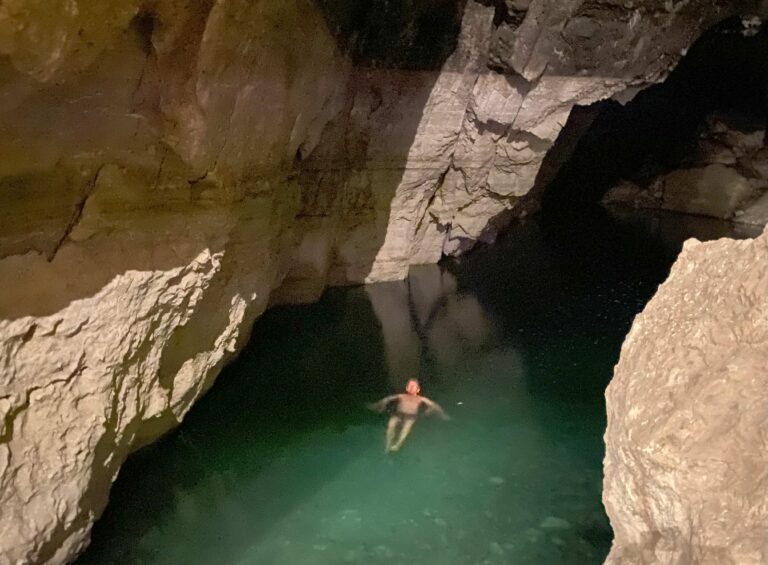
The warm water is sulphurous which means you’ll smell like a boiled egg for some time after a swim – but you’ll also reap the health spa-like benefits of sulphurous bathing. The fact that the cave also houses a really big bat colony only enhances the popularity of a day out here. It’s a hotspot and locals swim and hang out in the yurts back up on the surface, drinking tea and eating lamb shashlik, which goes nicely with the boiled-egg smell.
And then there’s Yangykala canyon. Few Turkmen, let alone foreigners, have even seen it. And no wonder – it’s far away from everything and nothing, a wild windblown jagged gash in the desert. We took a night train to Turkmenbashy and then drove a few more hours to reach it. Millions of years ago this was all ocean floor. The water disappeared and the elements etched the canyon in the coral sands.
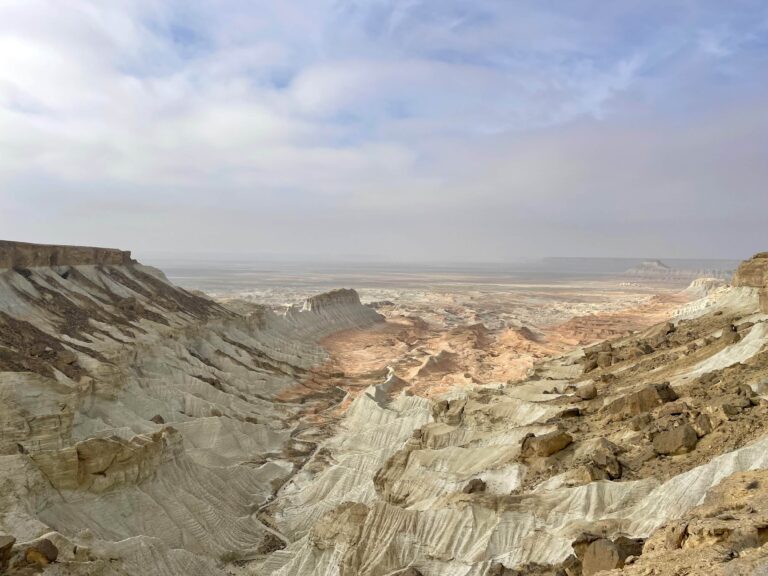
Shivering in a strong wind next to the car, slurping tea in that vast emptiness, it felt like nothing had changed since the ocean ebbed away.
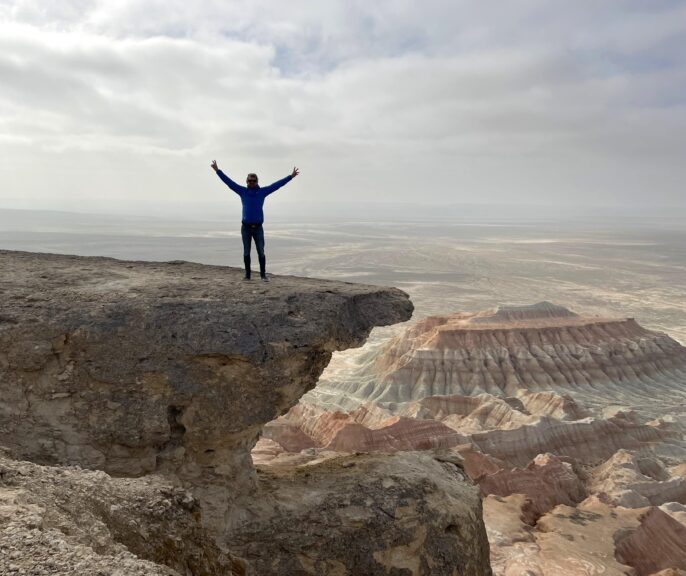
Turkmenistan is landlocked, although it does have a piece of shoreline on the Caspian Sea. Not really a sea, the Caspian is the world’s largest lake. I’m sure Turkmenistan would lay claim to that one somehow if only neighboring countries didn’t have lakefront property as well. I’ve been to some Caspian beaches before, in Kazakhstan. Given the choice I’d vastly prefer swimming in a bat infested underground gaseous pool so Turkmenistan wins after all.
In the early 2000s Turkmenbashi himself kicked off development of a National Tourist Zone called Avaza, next to the Caspian Sea. Marketed as a Turkmen Las Vegas, it’s full of lavish hotels and over-the-top entertainment options. But, like other Presidential projects such as downtown Ashgabat and the giant ferris wheel, it’s mainly deserted much of the time. The idea was that Avaza would draw in the tourists. But then someone must have remembered they don’t want tourists that much. So we just drove by the tourist zone that we as tourists would have visited – if it hadn’t been declared off-limits to international tourists.
Natural gas and an unnatural disaster
Way out there in the Karakum desert is Turkmenistan’s best kept secret. It’s not that nobody knows about it. Darvaza gas crater, better known as the Gates of Hell – is probably the country’s biggest draw. It’s more that nobody knows exactly how it happens to be there. Or, those who know aren’t telling, since the Soviets liked to keep their massive f**k-ups classified.
Turkmenistan’s got a lot of natural gas – the fifth largest reserves in the world (so hardly worth mentioning, since it’s not number one). It’s generally thought that in 1971 engineers were out in the desert drilling for oil, when the ground collapsed underneath them forming a crater. When they noticed the crater was steadily leaking gas (presumably after somehow climbing out of this 30-metre-deep gas-leaking pit), they thought they’d just set it on fire and burn off the gas in a few days. The fire is still burning now, five decades later.
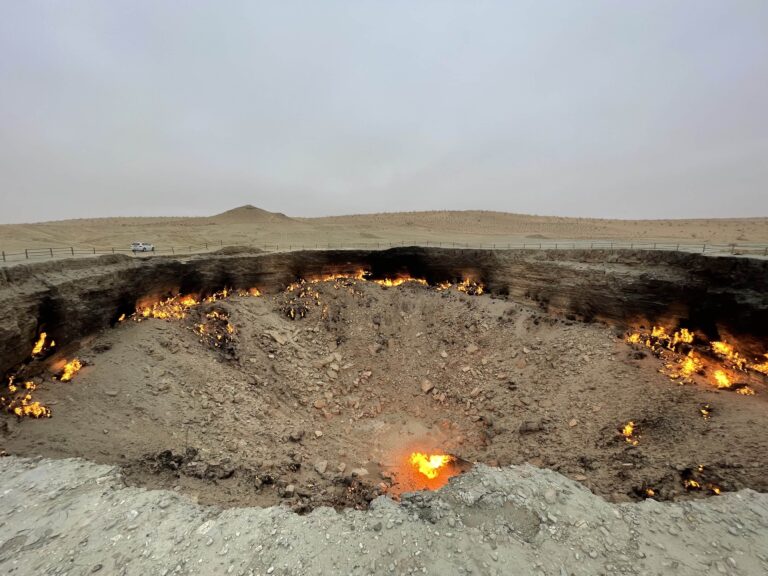
We drove out from Ashgabat late in the afternoon and stood on the edge of the crater. During the daytime it just looks like a lot of small fires in the sand. But after dinner (in a yurt, of course) we came back in the cold desert darkness and it looked a lot more – hellish.

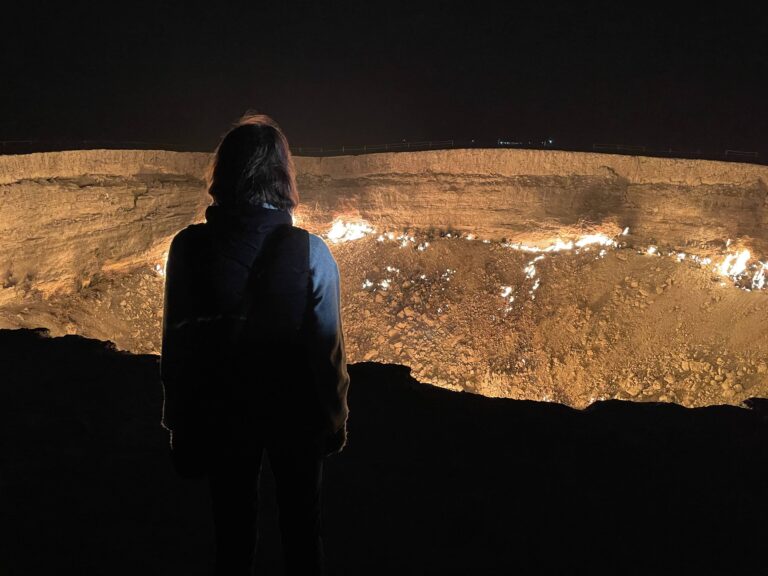
We asked Arslan about the fallout from this disaster. Engineers must have been killed when it happened. But nobody seems to know. ‘They’ve got pictures of Merv, from excavations in the early 1900s’ he said. ‘But nothing about this, it’s like it didn’t happen.’
A seriously remote finale
And then there’s Koytendag, or Turkmenistan in a microcosm as I like to think of it. In this seriously remote part of the country, near to the borders with Uzbekistan and Afghanistan, you get a little bit of everything that makes Turkmenistan so very Turkmenish. Minus the white marble.
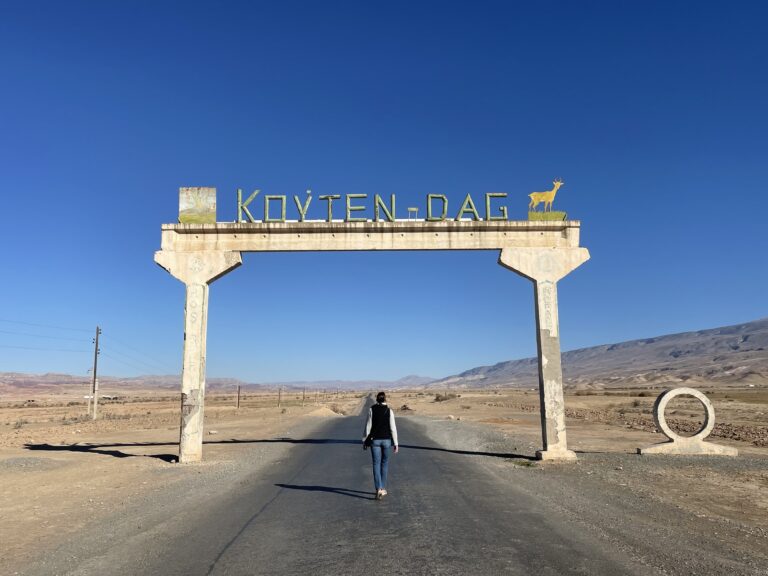
We got there on yet another night train with our long-suffering guide – it’s not a common stop on the typical itinerary. A new driver met us at the station in Kerki. It’s a town where, in the driver’s own words, ‘Dogs go to die’. We drove well out of town and moved into a mostly deserted camp. It reminded me of the sort of place where Rick and his people on the Walking Dead would establish yet another of their short-lived idyllic communities that quickly turns into a desperate last stand.
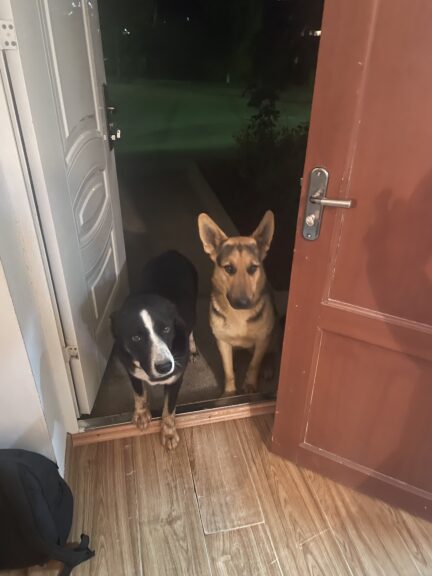
Oyv and I set off for an unsupervised stroll. Arslan let us loose as far as the edge of the village. ‘If anyone invites you in, just say no’ he reminded us. We already knew that – cultural exchange is not part of a visit to Turkmenistan.
But plenty of other things are.
Like walking in the 150 million year old footprints of dinosaurs. Local legend has it that the footprints actually belonged to elephants in Alexander the Great’s army (yes, he was here, too). We climbed up to the plateau where Megalosaurs once roamed.
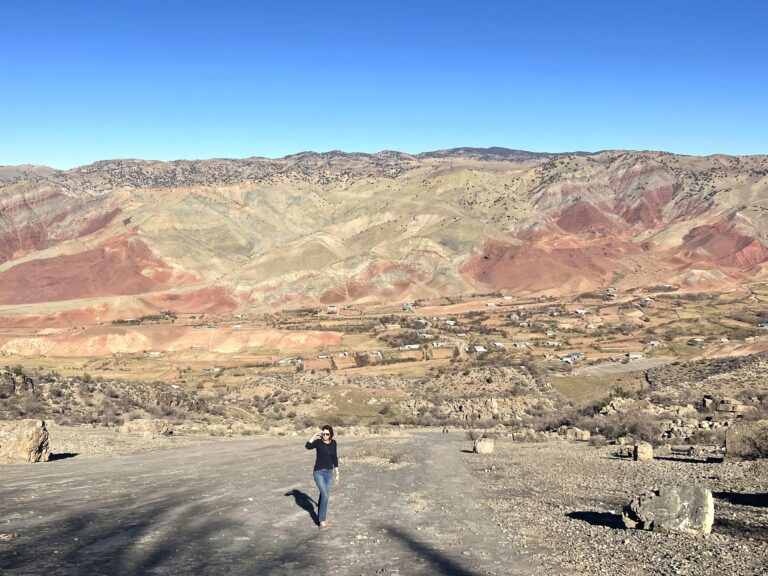
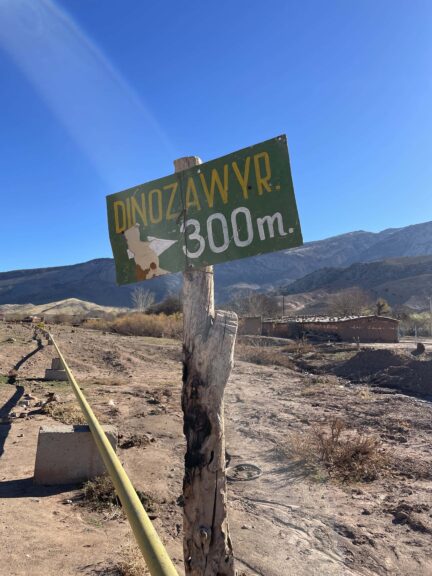
Their tracks in a shallow lagoon were preserved over millions of years when shifting tectonic plates first buried them, and then forced them back up to the surface. And guess what! We have another record-setter: it’s the world’s largest number of dinosaur footprints all in one place.
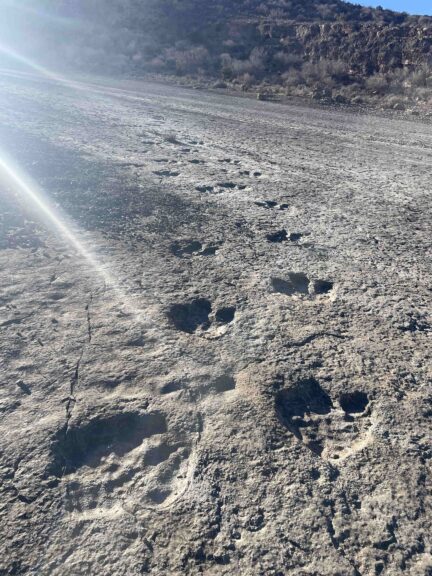
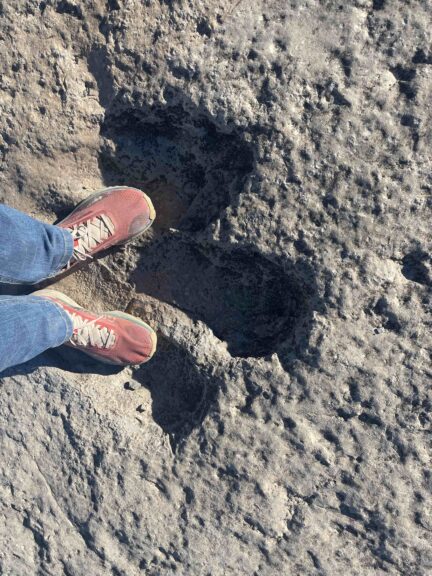
There’s also Buzkashi, aka Dead Goat Polo. We stumbled on a match in the desert. Yes, that’s right. Dozens of men on horseback galloping towards us at full-speed, fighting amongst themselves over the carcass of a goat. It’s a thing.
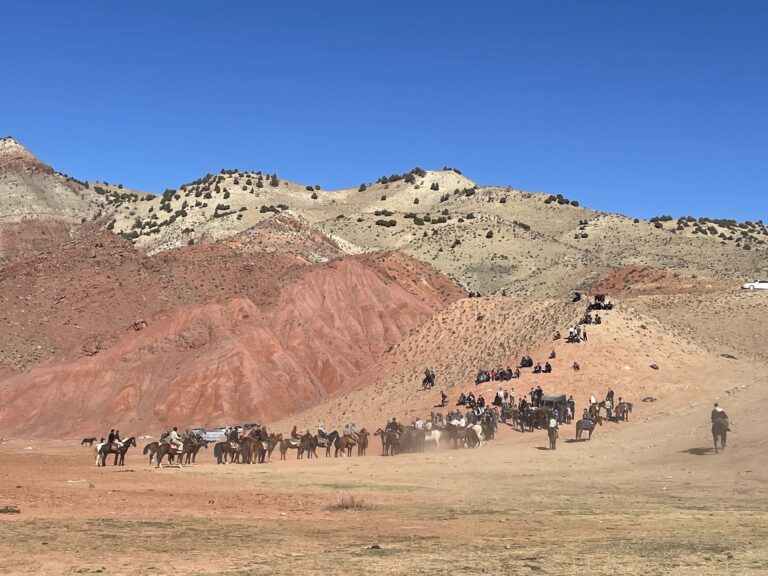
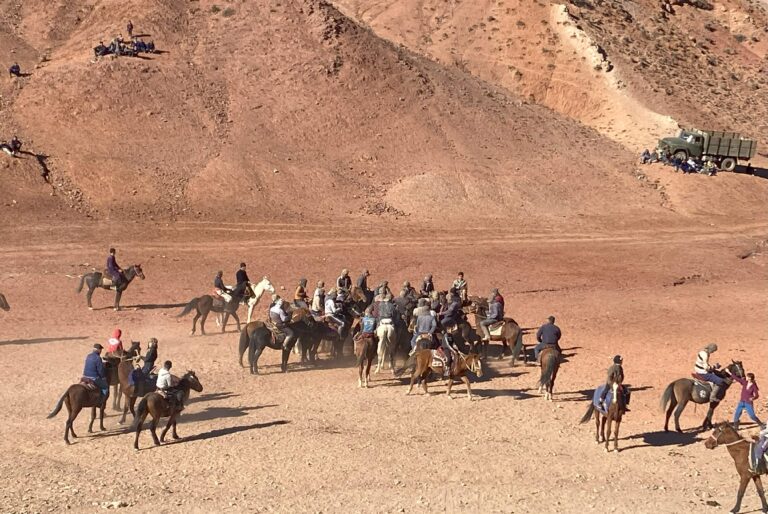
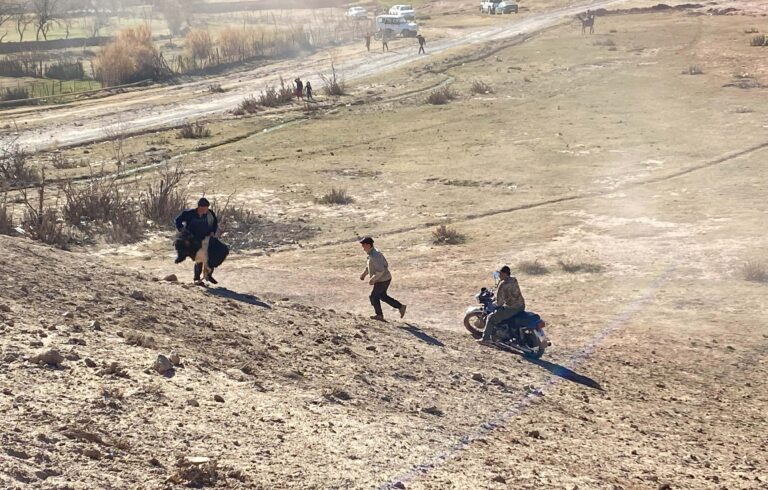
Our time in Turkmenistan was drawing to a close. There’s no spontaneity here when it comes to your exit date. You get out on the exact day your visa says you’re going, at the border you specified weeks ago on your painstakingly planned itinerary. We’d picked the border to Uzbekistan, another day’s drive from Koytendag.
But first, we unwound with a massage from a (still living) goat, which I think is self-explanatory. Or is it? In Turkmenistan almost anything seems plausible.
And here you go, just in case goat massage isn’t that self-explanatory:
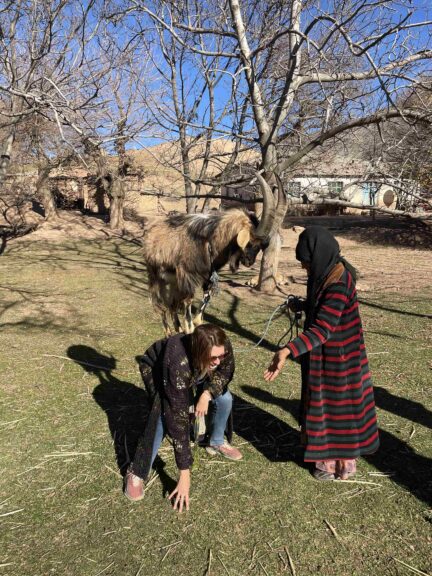
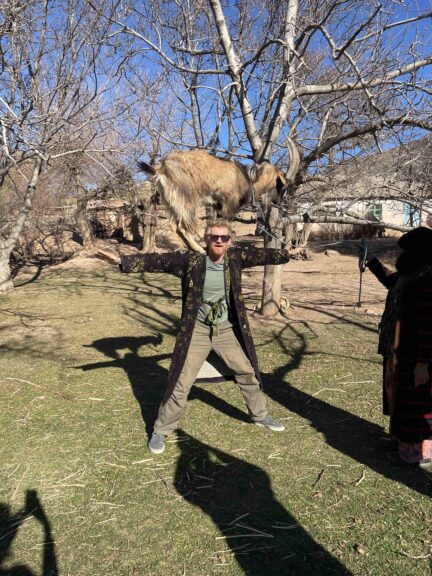
Read More
For more of our adventures (and misadventures) as we travel from Cameroon to Japan, check out the rest of my stories from the road.
Or, maybe you’re planning a trip to Turkmenistan yourself? Take a look at this guide: Planning a tour in Turkmenistan: our 9 day itinerary.




This Post Has 21 Comments
Love your descriptions and explanations of everything you see and do on your travels. Glad I can vicariously enjoy it! Thanks for sharing!
Thanks for reading, glad you enjoy it!
This was fascinating and wild! Thanks for sharing! God bless y’all, and keep sharing!
Thanks! Turkmenistan was definitely both those things 🙂
Woow
Amazing review. Miss my country. Thank you for exploring Turkmenistan territory. Stay safe. )))
Thank you:)
Planning to go there next year. Looks a bit complicated, will read your trip planning thoroughly. Thanks for sharing!!
You’re welcome! Have a great time:)
Hi Sarah. I am planning to go there. Could you pls tell me the tour operator that you used while you there and the costs?. Thanks for sharing!
Hey, it cost about 1500 USD per person for the two of us (private tour). On top of that, you need to add: tips to the guide and driver, some small amount of spending money, the visa itself and an arrival tax.
As a resident of Turkmenistan, I am glad to read your detailed description of your trip to our beautiful country. Waiting for you again. Thanks.
Hi Sarah, what a beautiful trip and great stories.
I have questions:
Did you tip in dollar or local currency?
And is a fluency in Russian Language enough to communicate in Turkmenistan?
Thank you for sharing.
Thanks! We tipped in a mix of dollars and local. Fluent Russian would be more than fine…I only know like, 6 words in Russian and had no problems:) If you have a guide, they should be English-speaking. If you’ve only got a driver, maybe not, but either way you aren’t really let loose to interact with locals in the first place so it’s not a big issue.
I really like your writing style. It combines factual information with humor. You made your visit to this questionable destination quite interesting. Kudos to you!
Thank you! 🙂
Excellent report on a fascinating country.My son in law and myself have been to very many countries of the world including dangerous places
Advised against by the British Foreign Office..we decided on Turkmenistan for the Gas crater and it was the only Stan we had not visited.
Your writing was a perfect piece in all respects and I am sure it will provoke much interest.FYI we went with an Australian co.
Intrepid Travel who were first class. The group were terrific 2 Brits. Us. 2 Germans. 2 Swiss. 3 Aussies 1 Taiwan.
Kind regards. Herbert Verity and Kevin Norton from Halifax Yorkshire UK
Brilliantly written and very entertaining.
Thanks! 🙂
I’m really enjoying this blog! Keep up the good work!
Loved this post — it reads like a wild travel doc meets satire. The mix of humor, surreal detail, and sharp honesty makes it super engaging. More of this vibe, please!